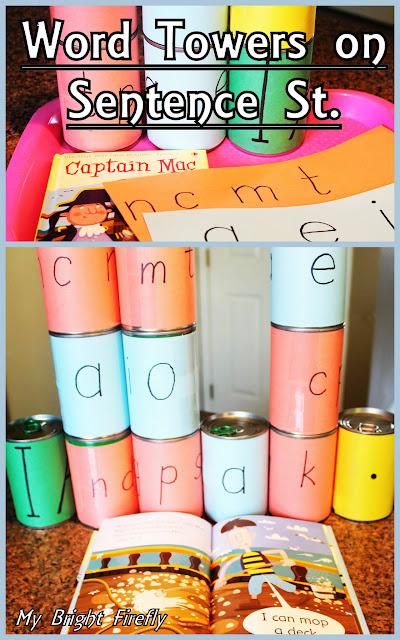Soup Can Word Towers on Sentence Street
Introduction to finger spaces between the words, capital letters at the beginning of the sentences, and punctuation at the end sounds boring and complicated for little ones.We needed a great visual for playing with the sentence in a fun way. Of course, cut and paste words to build a sentence is a great practice. But our awesome soup can towers served us well:
- Vegetable and soup cans are so fun to build with!
- We were able to observe and create words that are big and small, short and tall. Spacing the words using a finger was our new "magic trick".
- The first and last cans on our Sentence Street were "special" color coded cans. They got to be great manipulatives for playing with the new concepts. You can also find our pretend play set up for a period and a question mark here: Zookeeper Dramatic Play: Introducing a Question and a Question Mark.
The idea for these activities came from a wonderful new book that was released yesterday!
"100 Fun and Easy Learning Games for Kids" by Amanda Boyarshinov and Kim Vij is a great resource for preschool and kindergarten this summer. The book was sent to us for a review free of charge. All opinions in this post are my own. This article is not sponsored in any other way.
100 Fun and Easy Learning Games for Kids from The Educator's Spin on It.
Stack a Word
This activity has been reprinted with the permission from the publisher from book "100 Fun & Easy Learning Games for Kids".
Materials: construction paper, scissors, 10 cans of similar size, black marker, tape.
Directions to make:
- Cut 10 papers to wrap around the cans.
- Write two vowels and two consonants on each paper. Vary letter combinations to include all letters.
- Attach a letter paper to each can with tape.
- Write down on a separate paper select consonant-vowel-consonant (CVC) words in focused word family.
Introduction to a Sentence Dramatic Play
For these activities we used:- Color coded cans with four letters per each can,
- A book from Usborne Very First Reading series: "Captain Mac" by Russell Punter. Amazon affiliate link: Usborne Very First Reading 16 Books Box Set Collection Pack
.
We built the towers, noticed their sizes, spaced them out using a finger.
Finally, Captain Mac was able to drive a car down the street to check for the first and last cans on the street.
The cans are also color coded for the type of vegetables inside. So that if I need to use one, I'll know to open consonants or vowels. Yes, we store our new game supplies in the pantry - fun!
We missed a word! (Pictured below.) Will Captain Mac be able to find a missing tower?
Finally, Captain Mac was able to drive a car down the street to check for the first and last cans on the street.
The cans are also color coded for the type of vegetables inside. So that if I need to use one, I'll know to open consonants or vowels. Yes, we store our new game supplies in the pantry - fun!
We missed a word! (Pictured below.) Will Captain Mac be able to find a missing tower?
100 Fun and Easy Learning Games for Kids
"100 Fun and Easy Learning Games for Kids" by Amanda Boyarshinov and Kim Vij was our go-to resource for these activities. I love all the game ideas! They are fun, easy to set up, and just in time for the busy summer.
Amazon affiliate link: 100 Fun & Easy Learning Games for Kids: Teach Reading, Writing, Math and More With Fun Activities
My Firefly loved this book as much as I did. She paged through admiring the illustrations and exclaiming "I want to play this!" for each. I guess, we will be using this book A LOT during this summer. All the games are very easy to set up with the supplies that are readily available.
All the games are divided into six chapters: fantastic reading, amazing writing adventures, really cool math, super science, magical music and art, and going global.
"As the parents of children ages 2, 4, 5, and 8, we wanted to make sure that the skills our children worked so hard to learn would be remembered. We also wanted to extend our children's learning and challenge their thinking in fun ways." (From the authors of the book, p. 6)
All the games are divided into six chapters: fantastic reading, amazing writing adventures, really cool math, super science, magical music and art, and going global.
"As the parents of children ages 2, 4, 5, and 8, we wanted to make sure that the skills our children worked so hard to learn would be remembered. We also wanted to extend our children's learning and challenge their thinking in fun ways." (From the authors of the book, p. 6)
Yes, we were able to enjoy the challenge in fun ways with their first game, and are looking forward to so much more!
You are welcome to follow us:












